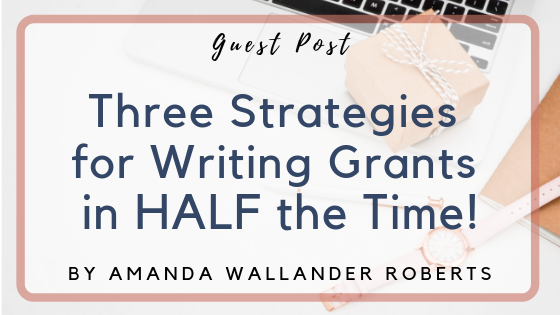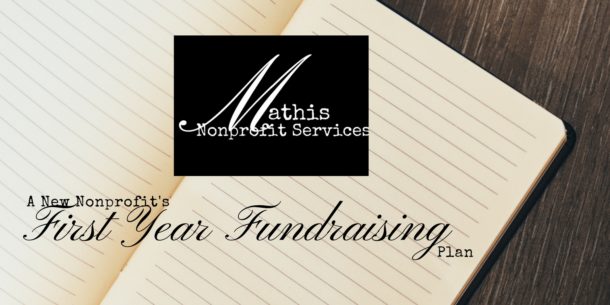As part of
Struggling to find the time to submit strong grant applications? You’re not alone! Many nonprofits— big and small— just don’t have the time to apply for all the amazing opportunities out there. This is a major reason why people hire grant writers and consultants. However, organizations unable to hire a grants-dedicated staff member or consultant can still get grant funding.
In order to help, I’ve outlined my top three strategies for writing grants in HALF the time! I have used these strategies on all sorts of grants, from one-page family foundation letters of inquiry to 100+ page federal grant applications and everything in-between. Every time, they have dramatically decreased the time I spend writing.
Strategy #1: Outline the Grant First
Before starting to write anything, I first create an outline for every letter of inquiry or grant application. This means copying and pasting or typing the questions and application requirements (e.g., character limits, review criteria, etc.) into a Word document. Even if the letter of inquiry is three questions to be submitted through a website contact form, I always start in Word.
It sounds counterintuitive and time-intensive, but here’s why creating an outline works:
- While copying the questions I am already thinking about where I want to put compelling information. For example, some grantors do not ask for needs assessment data, but I like to incorporate it whenever possible. Reviewing all the questions and criteria in this way prepares me to incorporate all my compelling information and write a response just once.
- Copying all the questions before writing helps me understand the grantor’s language and use it in my writing. Language regarding evaluation, for example, can vary widely between grantors. Whether they use “goals”, “outcomes”, etc., I can make a note of this while creating my outline and be prepared to write using their preferred terms.
- Keeping a copy of all grant submissions in Word also reduces the time it takes for the next application (see Strategy #2!), and reminds me what was promised in case another copy of the application isn’t accessible.
When writing a grant application, staring at a blank page can be stressful, de-motivating, and a huge waste of time.
Strategy #2: Start With What You Have
When writing a grant application, staring at a blank page can be stressful, de-motivating, and a huge waste of time. This is why I NEVER start from scratch. I copy and paste previous grant application responses, annual report language, etc. into the appropriate sections of the outline and then add to and edit the information. Even if it’s your first grant application, there is information you can pull from your website, newsletters, etc. that you can use to start grant writing.
Here is why starting with the information you have is so important:
- You don’t have to rewrite information that you (or someone else) has already written, which significantly reduces your writing time!
- Using existing language helps you keep messaging consistent, which is critical for your organization long-term. This increases brand recognition among grantors, which may help open the door for future grant opportunities.
- Keeping the same program outcomes and evaluation methods also reduce the number of things you have to track and report on. Grants for the same program should be using the exact same outcomes/goals and evaluation methods.
Strategy #3: If You Aren’t in the Mood to Write, Give Yourself a Break
You know that feeling like you’re in the “zone”? Some people call it flow or focus, but it’s that state of work where you’re not distracted or looking at the clock, you’re zeroed in on your work and doing a great job. That is when I write grants.
There is so much else to do in a day, that if I am not in the grant writing “zone” within 30 minutes I will switch to another task for a while. This is so important because if you aren’t feeling it, it can show in your writing. Grants require strong information that paints a compelling picture for funders. So, if you’re not in the mood to write the grant, and can’t get yourself in the mood after trying, then give yourself a break.
Here are a few tricks I regularly use to help me get in the zone:
- Start grants way ahead of time so that you can afford to take breaks without missing the deadline. Set a timer for 30 minutes and dive into the grant. After 30 minutes, decide whether you will continue working on the grant or switch tasks. A few 30 minute intervals focused on the grant can yield great results.
- After outlining a grant and copying and pasting information in the questions, make notes about what you want to include in your answer. Having information to start with can help you get in the mood to write more and edit.
- Set up your environment so you know it’s time to focus. For me this means having a warm cup of coffee, clearing my desk of papers, and closing all the tabs I’m not using on my computer. Almost every time I set up my environment to signal that it’s “focus time,” I’m able to make major progress towards completing a grant application.
Want to learn more about how to achieve #grantsuccess? Download our free Six Steps to Successful Grants, which shows the steps we use for every grant application and common grant pitfalls to avoid!
About Amanda

Amanda Wallander Roberts is a fundraising and evaluation coach and consultant who has a Master’s Degree in Social Work, with an emphasis in nonprofit management. She has more than ten years of experience working in programs serving children and youth and utilizes this experience to inform her work in fundraising, evaluation, and program development. She has directly worked with more than 60 social service organizations to build capacity in fundraising and/or evaluation, including raising over $23 million, developing more than 50 logic models, evaluation plans, and process maps, and providing coaching and training for nonprofit leaders. As one client put it, Amanda is “the secret weapon for any organization looking to grow their impact!” Connect with Amanda on LinkedIn, Facebook, Twitter, or Pinterest.


 Most nonprofit leaders lay awake at night trying to figure out how to fund their mission.
Hi! I'm Alesha.
I teach sustainable fundraising in a way that they can take action today so they can serve their clients.
I can help you move from just getting started funding your new nonprofit to gaining confidence in your fundraising and building relationships to knowing what works for your organization and looking at the infinite game when it comes to funding. I’ve worked with nonprofit Founders and written the book I HAVE MY 501(C)3! NOW WHAT?!? Your Blueprint to Starting Your Nonprofit Without Being the Sole Funder that lays the foundations for funding in a new nonprofit.
I’ve worked in Development (Fundraising) Departments in large organizations and I know the no cost, low-cost methods they use to bring in funding. I bring those sound strategies to the nonprofits I serve.
Most nonprofit leaders lay awake at night trying to figure out how to fund their mission.
Hi! I'm Alesha.
I teach sustainable fundraising in a way that they can take action today so they can serve their clients.
I can help you move from just getting started funding your new nonprofit to gaining confidence in your fundraising and building relationships to knowing what works for your organization and looking at the infinite game when it comes to funding. I’ve worked with nonprofit Founders and written the book I HAVE MY 501(C)3! NOW WHAT?!? Your Blueprint to Starting Your Nonprofit Without Being the Sole Funder that lays the foundations for funding in a new nonprofit.
I’ve worked in Development (Fundraising) Departments in large organizations and I know the no cost, low-cost methods they use to bring in funding. I bring those sound strategies to the nonprofits I serve.